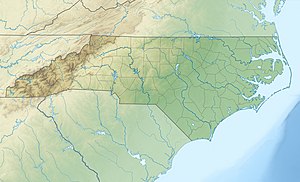| Laniers Creek Tributary to Uwharrie River | |
|---|---|
  | |
| Location | |
| Country | United States |
| State | North Carolina |
| County | Randolph |
| Physical characteristics | |
| Source | Cabin Creek divide |
| • location | pond at Complex, North Carolina |
| • coordinates | 35°33′56″N 080°03′52″W / 35.56556°N 80.06444°W / 35.56556; -80.06444 |
| • elevation | 705 ft (215 m) |
| Mouth | Uwharrie River |
| • location | about 1.5 miles east of New Hope, North Carolina |
| • coordinates | 35°33′27″N 079°58′37″W / 35.55750°N 79.97694°W / 35.55750; -79.97694 |
| • elevation | 367 ft (112 m) |
| Length | 5.99 mi (9.64 km) |
| Basin size | 9.75 square miles (25.3 km) |
| Discharge | |
| • location | Uwharrie River |
| • average | 11.53 cu ft/s (0.326 m/s) at mouth with Uwharrie River |
| Basin features | |
| Progression | Uwharrie River → Pee Dee River → Winyah Bay → Atlantic Ocean |
| River system | Pee Dee River |
| Tributaries | |
| • left | Sand Branch |
| • right | Nanny Branch |
| Bridges | Surratt Country Road, Johnson Farm Road, New Hope Road, Lou Cranford Road |
Laniers Creek is a 5.99 mi (9.64 km) long 2nd order tributary to the Uwharrie River in Randolph County, North Carolina. This is the only stream of this name in the United States.
Course
Laniers Creek rises in a pond on the Cabin Creek divide at Complex, North Carolina. Laniers Creek then flows easterly to join the Uwharrie River about 1.5 miles east of New Hope.
Watershed
Laniers Creek drains 9.75 square miles (25.3 km) of area, receives about 47.1 in/year of precipitation, has a wetness index of 398.45 and is about 39% forested.
See also
References
- ^ "GNIS Detail - Laniers Creek". geonames.usgs.gov. US Geological Survey. Retrieved 15 September 2020.
- ^ "Laniers Creek Topo Map in Randolph". TopoZone. Locality, LLC. Retrieved 15 September 2020.
- "ArcGIS Web Application". epa.maps.arcgis.com. US EPA. Retrieved 15 September 2020.
- ^ "Laniers Creek Watershed Report". US EPA Geoviewer. US EPA. Retrieved 15 September 2020.
This article related to a river in North Carolina is a stub. You can help Misplaced Pages by expanding it. |